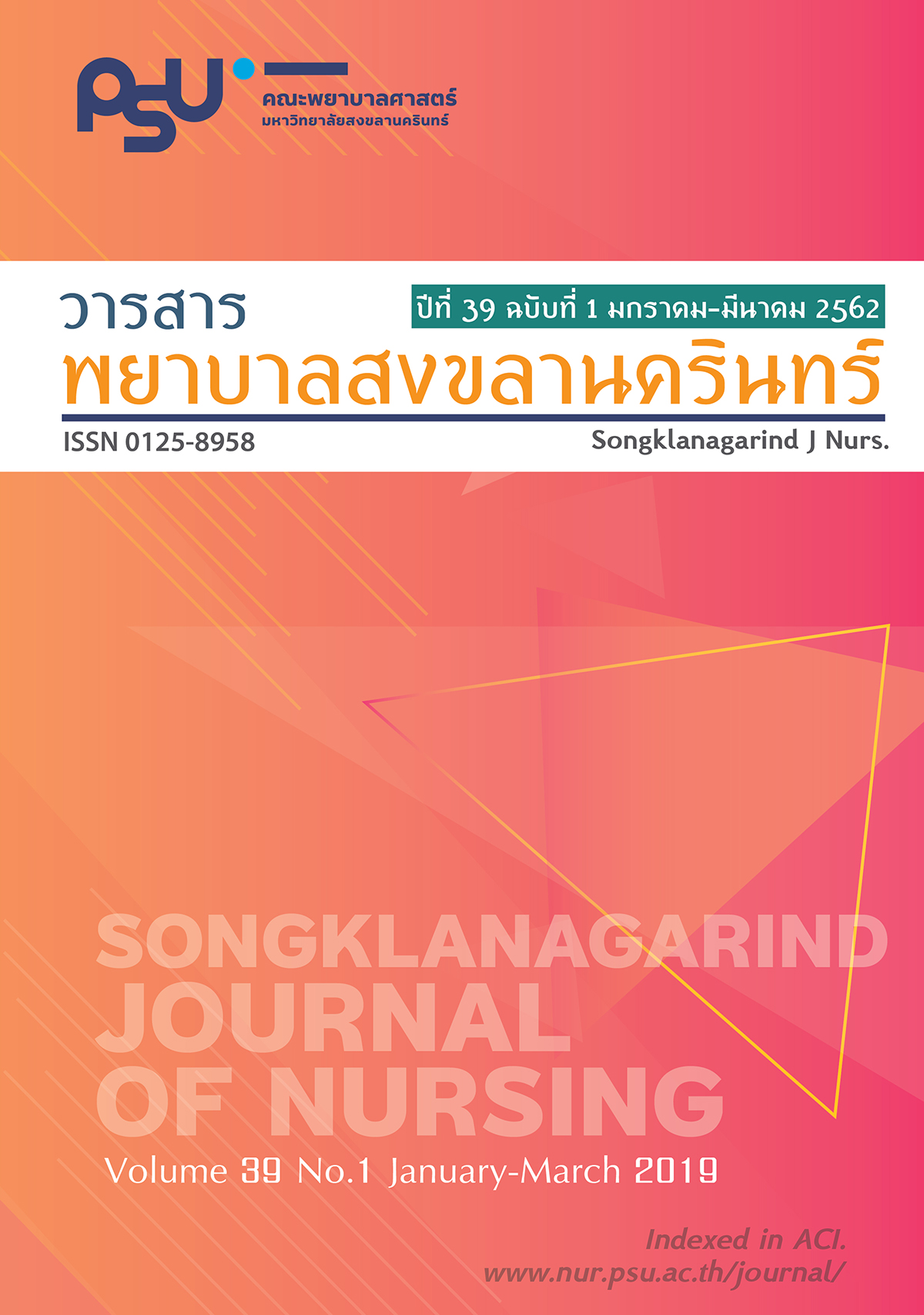Influences of Stress, Pain, and Nursing Care Activities on Sleep Quality in Children with Cancer Receiving Chemotherapy
Main Article Content
Abstract
This predictive study aimed to examine the predictive power of stress, pain, and nursing careThis predictive study aimed to examine the predictive power of stress, pain, and nursing careactivities on sleep quality in children receiving chemotherapy. Seventy-three children, aged 8-15 years were purposively selected while receiving chemotherapy. Data were obtained using the general data questionnaire, the Childhood Cancer Stressor Inventory, the Numeric Pain Rating Scale, the nursing care activities recording form, and the Children’s Sleep Habits Questionnaire. Descriptive statistics, Pearson’s product moment correlation, and stepwise multiple regression were used for data analyzis.
The results revealed that stress, pain, and nursing care activities could explain 53 percent of thevariance in sleep quality (R2= .53, F(3,69)= 25.91, p< .001). Nursing care activities had the greatest influenceon sleep quality followed by stress and pain (β=-51, p< .001, and β=-.30, β=-.23, p< .01, respectively).Therefore, nurses should have strategies to provide nursing care to reduce these factors, inturn enhancing the sleep quality of children receiving chemotherapy.
Article Details
References
Ward E, DeSantis C, Robbins A, et al. Childhood and adolescent cancer statistics. CA Cancer J Clin. 2014; 64(2): 83–103.
Centers for Disease Control and Prevention [Internet]. 10 leading causes of death by age group, United States-2015. 2015 [cited 2016 December 8]. Available from http://www.cdc.gov/nchs/fastats/leading-causes-of-death.htm
Imsamran W, Chaiwarawattana A, Wiangnon S, et al. [Internet]. Cancer in Thailand (Vol. VIII, 2010-2012). Bangkok: New thammada; 2015 [cited 2018 Jan 6]. Available from http://www.nci.go.th/th/File_download/Nci%20Cancer%20 Registry/Cancer%20in%20Thailand8.pdf
Ministry of Public Health. [Internet]. Public health statistics. 2016 [cited 2016 May 6]. Available from http://bps.moph.go.th/newbps/sites/default/ files/health_statistic_2559.pdf
Prechavittayakul P. Tumor registry. Songkla. Cancer unit. Songklanagarind hospitol; 2018 [cited 2015 May 6]. Available from http://medinfo2.psu.ac.th/cancer/caregistry.php
Walker AJ, Gedaly-Duff V, Miaskowski C, et al. Differences in symptom occurrence, frequency, intensity, and distress in adolescents prior to and one week after the administration of chemotherapy. J Pediatr Oncol Nurs. 2010; 27(5): 259–65.
Walker AJ, Johnson KP, Miaskowski C, et al. Sleep quality and sleep hygiene behaviors of adolescents during chemotherapy. J Clin Sleep Med. 2010; 6(5): 439–44.
LeBourgeois MK, Giannotti F, Cortesi F, et al. The relationship between reported sleep quality and sleep hygiene in Italian and American adolescents. Pediatrics. 2005; 115(1 Suppl): 257- 65.
Owens JA, Spirito A, McGuinn M. The Children’s Sleep Habits Questionnaire (CSHQ): Psycho- metric properties of a survey instrument for school-aged children. Sleep. 2000; 23(8): 1043- 51.
Daniel L. Sleep during the maintenance phase of treatment for acute lymphoblastic leukemia: a comparison of dexamethasone and prednisone [dissertaationn].philadelphia: Drexel University; 2011.
Hockenberry MJ, Hooke MC, Gregurich M, et al. Symptom clusters in children and adolescents receiving cisplatin, doxorubicin, or ifosfamide. Oncol Nurs Forum. 2010; 37(10): E16-27.
Orsey AD, Wakefield DB, Cloutier MM. Physical activity (PA) and sleep among children and adolescents with cancer. Pediatr Blood Cancer. 2013; 60(11): 1908-13.
Zupanec S, Jones H, Stremler R. Sleep habits and fatigue of children receiving maintenance chemotherapy for ALL and their parents. J Pediatr Oncol Nurs. 2010; 27(4): 217-28.
Rosen G, Brand SR. Sleep in children with cancer: case review of 70 children evaluated in a comprehensive pediatric sleep center. Support Care Cancer. 2011; 19: 985-94.
National Sleep Foundation [Internet]. What happens when you sleep?; 2018 [cited 2018 Mar 7]. Available from https://sleepfoundation. org/how-sleep-works/what-happens-when- you-sleep
Mindell JA, Owens JA. A clinical guide to pediatric sleep: Diagnosis and management of sleep problems (2nd ed.). Philadelphia: Lippincott Williams & Wilkins; 2010.
Tisara P. Influences of fatigue and sleep disturbance on functional status of children with cancer receiving chemotherapy [thesis]. [Chiangmai]: Chiangmai University; 2009. 115 p.
Patoomwan A, Hanprasitkam K, Rompipat S. Predicting factors of fatigue in children receiving chemotherapy for acute lymphoblastic leukemia. Journal of science and technology. 2013; 21(7): 595-608. Thai.
van Litsenburg RL, Huisman J, Hoogerbrugge PM, et al. Impaired sleep affects quality of life in children during maintenance treatment for acute lymphoblastic leukemia: An exploratory study. Health Qual Life Outcomes. 2011; 9: 25-31.
Rosen GM. Sleep and wakefulness in children with brain tumors. Sleep Med Clin. 2008; 3(3): 455-67.
Linder LA, Christian BJ. Nighttime sleep disruptions, the hospital care environment, and symptoms in elementary school-age children with cancer. Oncol Nurs Forum. 2012; 39(6): 553-61.
Rodriguez EM, Dunn MJ, Zuckerman T, et al. Cancer-related sources of stress for children with cancer and their parents. J Pediatr Psychol. 2012; 37(2): 185–97.
Punthmatharith B, Buddharat U, Wattanasit P. Quality of life of children with cancer: Do caregivers perceive differently? Songkla Med J. 2013; 31(3):123-35. Thai.
Moscou-jackson G, Allen J, Kozachik S, et al. Acute pain and depressive symptoms: Independent predictors of insomnia symptoms among adults with Sickle Cell Disease. Pain Manag Nurs. 2017; 17(1):38–46.
Borbely, AA., & Achermann, P. Sleep homeostasis and models of sleep regulation. In: Kryger MH., Roth T, Dement WC, Editors. Principle and practice of sleep medicine. 5th ed. Philadelphia: Saunders; 2011. pp. 431-4.
Han KS, Kim L, Shim I. Stress and Sleep Disorder. Exp Neurobiol. 2012; 21(4): 141-50.
Gauchat A, Séguin JR, Zadra A. Prevalence and correlates of disturbed dreaming in children. Pathol Biol. 2014; 62(5): 311-8.
Srisatitnaragun B. Nursing research methodology. 5th ed. Bangkok: U&I intermedia; 2010. 153 p. Thai.
Hockenberry-Eaton M, Manteuffel B, Bottomley S. Development of two instruments examining stress and adjustment in children with cancer. J Pediatr Oncol Nurs. 1997; 14: 178-85.

